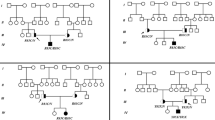Summary
Deficiency of liver glycogen phosphorylase in glycogen storage disease (GSD) type VI results in a reduced ability to mobilize glucose from glycogen. Six mutations of the PYGL gene, which encodes the liver isoform of the enzyme, have been identified in the literature. We have characterized eight patients from seven families with GSD type VI and identified 11 novel PYGL gene defects. The majority of the mutations were missense, resulting in the substitution of highly conserved residues. These could be grouped into those that were predicted to affect substrate binding (p.V456M, p.E673K, p.S675L, p.S675T), pyridoxal phosphate binding (p.R491C, p.K681T), or activation of glycogen phosphorylase (p.Q13P) or that had an unknown effect (p.N632I and p.D634H). Two mutations were predicted to result in null alleles, p.R399X and [c.1964_1969inv6;c.1969+1_+4delGTAC]. Only 7 of the 23 (30%) reported PYGL alleles carry nonsense, splice site or frameshift mutations compared to 68–80% of affected alleles of the highly homologous muscle glycogen phosphorylase gene, PYGM, that underlie McArdle disease. There was heterogeneity in the clinical symptoms observed in affected individuals. These varied from hepatomegaly and subclinical hypoglycaemia, to severe hepatomegaly with recurrent severe hypoglycaemia and postprandial lactic acidosis. We conclude that deficiency of liver glycogen phosphorylase is predominantly the result of missense mutations affecting enzyme activity. There are no common mutations and the severity of clinical symptoms varies significantly.
Similar content being viewed by others
References
Andreeva IE, Rice NA, Carlson GM (2002) The regulatory alpha subunit of phosphorylase kinase may directly participate in the binding of glycogen phosphorylase. Biochemistry (Mosc) 67: 1197–1202.
Barford D, Johnson LN (1989) The allosteric transition of glycogen phosphorylase. Nature 340: 609–616.
Bonfield JK, Rada C, Staden R (1998) Automated detection of point mutations using fluorescent sequence trace subtraction. Nucleic Acids Res 26: 3404–3409.
Bruno C, Cassandrini D, Martinuzzi A, et al (2006) McArdle disease: the mutation spectrum of PYGM in a large Italian cohort. Hum Mutat 27: 718.
Buchbinder JL, Rath VL, Fletterick RJ (2001) Structural relationships among regulated and unregulated phosphorylases. Annu Rev Biophys Biomol Struct 30: 191–209.
Burwinkel B, Bakker HD, Herschkovitz E, Moses SW, Shin YS, Kilimann MW (1998) Mutations in the liver glycogen phosphorylase gene (PYGL) underlying glycogenosis type VI. Am J Hum Genet 62: 785–791.
Chang JC, Kan YW (1979) beta 0 thalassemia, a nonsense mutation in man. Proc Natl Acad Sci USA 76: 2886–2889.
Chang S, Rosenberg MJ, Morton H, Francomano CA, Biesecker LG (1998) Identification of a mutation in liver glycogen phosphorylase in glycogen storage disease type VI. Hum Mol Genet 7: 865–870.
DeLano WL (2002) The PyMOL Molecular Graphics System on World Wide Web. http://www.pymol.org.
Emsley P, Cowtan K (2004) Coot: model-building tools for molecular graphics. Acta Crystallogr D Biol Crystallogr 60: 2126–2132.
Geremia S, Campagnolo M, Schinzel R, Johnson LN (2002) Enzymatic catalysis in crystals of Escherichia coli maltodextrin phosphorylase. J Mol Biol 322: 413–423.
Hudson JW, Golding GB, Crerar MM (1993) Evolution of allosteric control in glycogen phosphorylase. J Mol Biol 234: 700–721.
Lederer B, Stalmans W (1976) Human liver glycogen phosphorylase. Kinetic properties and assay in biopsy specimens. Biochem J 159: 689–695.
Lowe ED, Noble ME, Skamnaki VT, Oikonomakos NG, Owen DJ, Johnson LN (1997) The crystal structure of a phosphorylase kinase peptide substrate complex: kinase substrate recognition. EMBO J 16: 6646–6658.
Martin JL, Johnson LN, Withers SG (1990) Comparison of the binding of glucose and glucose 1-phosphate derivatives to T-state glycogen phosphorylase b. Biochemistry 29: 10745–10757.
Martín MA, Rubio JC, Buchbinder J, et al (2001) Molecular heterogeneity of myophosphorylase deficiency (McArdle’s disease): a genotype–phenotype correlation study. Ann Neurol 50: 574–581.
Newgard CB, Fletterick RJ, Anderson LA, Lebo RV (1987) The polymorphic locus for glycogen storage disease VI (liver glycogen phosphorylase) maps to chromosome 14. Am J Hum Genet 40: 351–364.
Newgard CB, Littman DR, van Genderen C, Smith M, Fletterick RJ (1988) Human brain glycogen phosphorylase. Cloning, sequence analysis, chromosomal mapping, tissue expression, and comparison with the human liver and muscle isozymes. J Biol Chem 263: 3850–3857.
Oikonomakos NG, Johnson LN, Acharya KR, et al (1987) Pyridoxal phosphate site in glycogen phosphorylase b: structure in native enzyme and in three derivatives with modified cofactors. Biochemistry 26: 8381–8389.
Rath VL, Ammirati M, LeMotte PK, et al (2000) Activation of human liver glycogen phosphorylase by alteration of the secondary structure and packing of the catalytic core. Mol Cell 6: 139–148.
Reese MG, Eeckman FH, Kulp D, Haussler D (1997) Improved splice site detection in Genie. J Comput Biol 4: 311–323.
Rogozin IB, Milanesi L (1997) Analysis of donor splice sites in different eukaryotic organisms. J Mol Evol 45: 50–59.
Schinzel R, Palm D (1990) Escherichia coli maltodextrin phosphorylase: contribution of active site residues glutamate-637 and tyrosine-538 to the phosphorolytic cleavage of alpha-glucans. Biochemistry 29: 9956–9962.
Shaltiel S, Hedrick JL, Pocker A, Fischer EH (1969) Reconstitution of apophosphorylase with pyridoxal 5’phosphate analogs. Biochemistry 8: 5189–5196.
Tang NL, Hui J, Young E, et al (2003) A novel mutation (G233D) in the glycogen phosphorylase gene in a patient with hepatic glycogen storage disease and residual enzyme activity. Mol Genet Metab 79: 142–145.
Xu YH, Carlson GM (1999) Structural features contributing to complex formation between glycogen phosphorylase and phosphorylase kinase. Biochemistry 38: 9562–9569.
Author information
Authors and Affiliations
Corresponding author
Additional information
Communicating editor: Alberto Burlina
Competing interests: None declared
References to electronic databases: Glycogen storage disease (GSD) type VI: OMIM 232700. Hugo Approved gene symbol: PYGL. GenBank accession no. of WT sequence: NM_002863.3. Glycogen phosphorylase: EC 2.4.1.1.
Rights and permissions
About this article
Cite this article
Beauchamp, N.J., Taybert, J., Champion, M.P. et al. High frequency of missense mutations in glycogen storage disease type VI. J Inherit Metab Dis 30, 722–734 (2007). https://doi.org/10.1007/s10545-007-0499-9
Received:
Revised:
Accepted:
Published:
Issue Date:
DOI: https://doi.org/10.1007/s10545-007-0499-9




